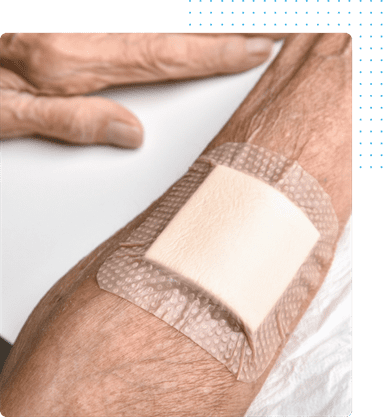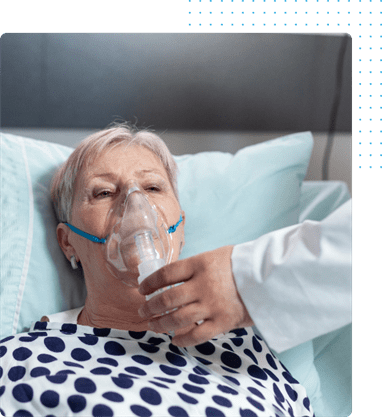Trilab Health has partnered with MSGI and ThermoFischer, the foremost leaders in the industry to create proprietary Lab Developed Tests (LDT) using high throughput automation systems. Trilab is at the forefront of providing care to Women’s Health, Wound Care, UTI and Respiratory testing.
Molecular diagnostics is quickly replacing the gold-standard in diagnostics for infectious diseases by providing the necessary sensitivity, specificity, and turnaround time to support the decision-making process and enable better patient management.

Over 75
Individual Molecular Tests Performed

Over 100,000
Patients Cared For

Over 100,000
Molecular Tests Performed

Wound Care
Trilab works with prominent primary, post, and urgent care centers to minimize turnaround times and optimize clinical decision-making.
Advancements in molecular diagnostic medicine allow for the identification of the most common organisms present within a wound, irrespective of the ability of these organisms to be grown in culture.
Wound care can be both chronic and acute. Advances in PCR allow for absolute identification of these microorganisms from very small sample sizes. PCR can also provide a quantitative representation of all microorganisms contributing to these polymicrobial infections.
These advances significantly shorten the time required to identify and treat chronic or acute wounds As a result practitioners will experience better patient outcomes and care quality metrics.
Women's Health And STI
Women’s health is an important part of diagnostic medicine as health needs change at every age and stage of life. Clinicians are faced with increasing challenges in managing patient needs when it comes to reproductive health. Staggering costs to the U.S. healthcare system caused by the growing number of new infections demand action in the way we test for sexually-transmitted infections (STIs).
- For vaginal infections, traditional diagnostics leave up to 40% of women with vaginitis undiagnosed after an initial clinical visit.
- Chlamydia trachomatis (CT), Neisseria gonorrhoeae (GC), and Trichomonas vaginalis (TV) are the most prevalent non-viral causes of sexually transmitted infections and accounted for ~$1.1 billion in direct medical costs in 2018.
- Screening and early detection of HPV and HSV can avoid the downstream consequences of untreated STIs.


UTI
UTI’s are a result of pathogens that can go to any part of your urinary system including your kidneys, bladder, ureters, and urethra. Trilab Health uses PCR to detect drug resistance markers and identify organisms.
Repeated UTI’s can have a deep and lasting impression and be difficult to diagnose. Often, patients are treated on symptoms alone but the diagnosis of UTI by clinical criteria alone has an error rate of approximately 33%.
Mutli-drug resistant organisms develop over time in a population due to repeated use of prophylactic antibiotics to fight infections. As organisms develop resistance to antibiotics, it becomes more important to treat based on specific organism and resistance.
Molecular based diagnosis can identify the cause of UTI within hours. UTI pathogens are not only detected with greater accuracy but our tests are able to provide treatment specifics.
Respiratory
With SARS CoV-19 still prominent in todays world it can be difficult to distinguish between the many pathogens responsible for a upper or lower respiratory infection.
Our Respiratory testing includes:
- SARS CoV-19 two gene testing along with the option to test for Influenzae A and B to help provider decision making
- We offer individual testing as well as respiratory panel testing for use during flu season and upticks in other common infections.


current US nursing home residents had pressure ulcers

Women test positive for a Sexually Transmitted Infection (STI) on any given day

of women in the United States will develop a urinary tract infection (UTI) at some point in their lifetime
- Acinetobacter baumannii
- Citrobacter freundii
- Enterobacter aerogenes
- Enterobacter cloacae
- Enterococcus faecalis
- Enterococcus faecium
- Escherichia coli
- Klebsiella oxytoca
- Klebsiella pneumoniae
- Morganella morganii
- Proteus mirabilis
- Proteus vulgaris
- Staphylococcus aureus
- Candida albicans
- Candida glabrata
- Candida parapsilosis
- Candida tropicalis
- Bacteroides fragilis
- Citrobacter braakii
- Clostridium novyi
- Clostridium perfringens
- Clostridium septicum
- Kingella kingae
- Psuedomonas aeruginosa
- Streptococcus pyogenes
- Acinetobacter baumannii
- Actinobaculum schaalii
- Aerococcus urinae
- Alloscardovia Omnicolen
- Citrobacter freundii
- Coagulase-negative
- Corynebacterium riegelii
- Enterobacter aerogenes
- Enterobacter cloacae
- Enterococcus faecalis
- Enterococcus faecium
- Escherichia coli
- Klebsiella oxytoca
- Klebsiella pneumoniae
- Morganella morganii
- Mycoplasma hominis
- Proteus mirabilis
- Proteus vulgaris
- Providencia stuartii
- Pseudomonas aeruginosa
- Serratia marcescens
- Staphylococci
- Staphylococcus aureus
- Staphylococcus saprophyticus
- Streptococcus agalactiae
- Viridans Group Strep
- Candida albicans
- Candida glabrata
- Candida parapsilosis
- Candida tropicalis
- Atopobium vaginae
- Bacteroides fragilis
- BVAB2
- Mycoplasma hominis
- Gardnerella vaginalis
- Haemophilus ducreyi
- Lactobacillus crispatus
- Lactobacillus gasseri
- Lactobacillus iners
- Lactobacillus jensenii
- Megasphera 1
- Megasphera 2
- Mobiluncus curtisii
- Mobiluncus mulieris
- Ureaplasma urealyticum
- Prevotella bivia
- Enterococcus faecalis
- Candida albicans
- Candida dubliniensis
- Candida glabrata
- Candida krusei;Pichia kudriavzevii
- Clavispora lusitaniae;SKN7
- Candida parapsilosis
- Candida tropicalis
- Mycoplasma genitalium
- Chlamydia trachomatis
- ALPHA-TUB1;Trichomonas vaginalis
- HSV1
- HSV2
- Neisseria gonorrhoeae
- Treponema pallidum (Syphilis)
- Staphylococcus aureus
- Streptococcus agalactiae
- Escherichia coli
- Mycoplasma hominis
- Gardnerella vaginalis
- Haemophilus ducreyi
- Ureaplasma urealyticum
- Mycoplasma genitalium
- Chlamydia trachomatis
- HSV1
- HSV2
- Neisseria gonorrhoeae
- Treponema pallidum
- Trichomonas vaginalis
- Human papillomavirus 16
- Human papillomavirus 18
- SARS – COVID 19
- Influenza A
- Influenza B
Drug Resistance Tests
Drug resistance testing allows providers to focus their treatment with effective antibiotics. This not only reduces time to recovery but can lower rates of complication as well as help minimize development of multi-drug resistant infections
- mecA
- AmpC
- Carbapenem (BlaKPC)
- ESBL (blaCTX-M)
- Macrolide (Mef(A))
- Quinolone-Fluoroquinolone (qnrA, qnrS)
- Vancomycin (VanA1, VanA2, VanB)
- Tetracyclin
What sets Trilab Health apart?
Trilab maintains it stand at the forefront of new developments in molecular diagnostics testing, so our partners
can provide the best combination of therapeutic options to their patients. The foundation of our lab is centered
around quality, efficiency and access.
Trilab Trifecta - QEA
Quality
by providing precise results with sensitivities and specificities while maintaining CLIA/COLA Accreditations and internal Quality Metrics to ensure accurate results are delivered every time.
Efficiency
Trilab maintains industry leading turnaround times on all testing that not only minimizes our partners time to treat but enables for accurate treatment the first time. We optimize our processes using six sigma to ensure that your providers have their results when they need them.
Access
Trilab not only provides accurate results through multiple different mediums of exchange from HL7 to easy access portals, but opens the door to a plethora of academic information. Providing peer-to-peer discussions, industry standard updates and academic updates when you need them. You have access to an industry-leading team of experts to assist you with clinical to pharmaceutical needs.

